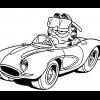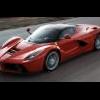Search the Community
Showing results for tags 'eyesight'.
-
I am starting this new thread/topic on Subaru EyeSight as there have been many discussions among the Impreza, XV and Forester forums, and many Owners are cautious about having solar film fitted to the front windscreen. I collected my SK Forester last week and has been exploring the EyeSight system since then. Let's start with MI disclaimer whereby buyer has to put his/her signature on the declaration form. In my opinion, the disclaimer is very relevant. Why is this so? The EyeSight system allows the driver to drive with it OR to manually switch-off either lane-departure detection or pre-collision braking or both features altogether. The 2 switches are located on the cabin roof, above the rear view mirror. In other words, Subaru (or anybody else) will not know whether the EyeSight was in operation should a front collision occurs. Also, EyeSight will not work above 60 km/h (+ / - ). What will happen if a crazy driver drives at high speed and crash his Subie and then seek legal compensation from Subaru for the "defective" EyeSight system. I am sure all other car manufacturers that offer driver assist crash avoidance system will insist buyers to sign the Disclaimer form. At the end of the day, the driver is still fully responsible for the vehicle safety, not technology. To be continued ...
- 52 replies
-
- 5
-

-
- subaru
- windscreen solar film
- (and 8 more)
-
I can't seem to find a "Health" forum. I think there should be one. But here goes : Declining eyesight can be improved by looking at red light, pilot study says By Ryan Prior, CNN Updated 1700 GMT (0100 HKT) June 30, 2020 (CNN)It will be as easy as brushing your teeth or shaving, and as long as future studies support it, it just might save your eyesight. A few minutes of looking into a deep red light could have a dramatic effect on preventing eyesight decline as we age, according to a new study published this week in The Journals of Gerontology. If the results are replicated in future studies, and approved by the US Food and Drug Administration, the light could augur a new era in which millions of people have access to the easy home-based therapy. It would give them a new layer of protection against the natural aging processes that steal our eyes' sensitivity to light and ability to distinguish colors. "You don't need to use it for very long to start getting a strong result," said lead author Glen Jeffery, a professor of neuroscience at University College London's Institute of Ophthalmology. The science works, Jeffery said, because the light stimulates the health of mitochondria, which are like batteries in our cells. And because mitochondria are implicated in a broad range of diseases, insights like these could help lead to new treatments for diseases including Parkinson's and diabetes. All it takes is a few minutes The study was small, a pilot study to test the concept. Researchers recruited 12 men and 12 women, whose ages ranged from 28 to 72. Each participant was given a small handheld flashlight that emitted a red light with a wavelength of 670 nanometers. That wavelength is toward the long end of the visible spectrum, and just short of an infrared wavelength, which tends to be invisible to the human eye. They spent three minutes each day looking into the light over a period of two weeks. The lights work on both cones and rods in the eye. Cones are photo receptor cells that detect color and work best in well-lit situations. Rods, which are much more plentiful, are retina cells that specialize in helping us see in dim light, according to the American Academy of Ophthalmology. Researchers measured the cone function in subjects' eyes by having them identify colored letters with low contrast. And they measured their eyes' rod sensitivity by asking them to detect light signals in the dark. There was a 14% improvement in the ability to see colors, or cone color contrast sensitivity, for the entire two dozen participants. Improvement, however, was most significant in study participants over age 40. For those ages, cone color contrast sensitivity rose by 20% over the course of the study. That age bracket also saw significant increases in rod threshold, which corresponds to the ability to see in low light. Study participants under 40 also experienced some improvement, but didn't see the same jump as older subjects. Younger eyes haven't declined as much as older eyes. "The retina ages faster than any other organ in your body," Jeffery said. "From an evolutionary perspective, we fundamentally have never lived past 40." Now, of course, we regularly live well beyond that age, and need ways to nurture the organs that for millennia have been the most likely to wear out earliest in life. Adults ages 40 and higher are are at the highest risk for eye diseases such as cataracts, diabetic retinopathy, glaucoma and age-related macular degeneration, according to the US Centers for Disease Control and Prevention. These diseases can occur in young people but their prevalence increases with age. At the beginning stages, these conditions are treatable, although they can start creeping in before symptoms appear. That's why the AAO recommends increasing regular eye exams to every two to four years for people once they cross age 40, and to increase exams to every one to two years at age 65. The CDC notes that the progression of these diseases can also be slowed by eating a diet rich in antioxidants and maintaining normal levels of blood sugar, body weight and blood pressure. If those indicators get out of normal range, they can further degeneration by breaking down blood vessels in the eyes, the American Heart Associations says. It's easy and safe to use This new study in humans builds on results in fruit flies and in mice, which also showed that red light could improve the functioning of mitochondria. For instance, a 2015 study showed that near-infrared light could spur energy production, improve mobility and extend the lifespan of fruit flies. And a 2017 study of visible red light at the edge of infrared reported a 25% improvement in the functioning of retinas in mice. Longer-term independent safety studies of red lights in humans would have to garner similar benefits for this method of eyesight protection to be approved by the FDA. If so, you'd still need to use a properly vetted product under a doctor's supervision. For example, while the laser pointers approved by the FDA for sale in the US don't cause eye damage, a 2018 case study in the New England Journal of Medicine outlined how a boy in Greece permanently injured an eye by pointing a green laser pointer into it. One of the best assets of the red lights they used is that they are safe, Jeffery said. The researchers all tested the red lights on their own eyes before beginning the study and have found no ill effects. The research subjects in the study also reported no ill effects. "If you use this every day, we have no evidence to say it's detrimental," Jeffery said. That fits with prior research, in which the safety of red lights has long been established, explained Dr. Raj Maturi, an associate professor at Indiana University School of Medicine. "It would be a very easy pathway to FDA approval," he said. But more studies are needed to prove it helps Although these lights aren't harmful, Maturi wasn't ready to embrace the idea that they're incredibly helpful either. This pilot study lacked a control group of patients who could have been exposed to a dummy light that emitted, he noted. The results found in this small study of 24 participants might not bear out in the larger population. Of the subjects over 40 in this study, individual characteristics of a few of them would be enough to make the eyesight improvements look stronger than they actually are. "The data set could be brought down by three or four subjects," he said. And while participants improved in how they saw the blue color axis, Maturi pointed out that they didn't have statistically significant gains in how they saw the red color axis. To really test these insights, it'll take a double-blind controlled study with a larger group of subjects and longer monitoring over time. LED lights could help with many diseases LED lights work in this arena because of what scientists call the mitochondrial theory of aging, in that humans and animals age as damage accumulates in mitochondria and mitochondrial DNA. Therefore stimulating mitochondria to reduce damage is a way of slowing aging in general. Our retinas are chock-full of mitochondria — the highest concentration of mitochondria of any part of the body. That's a main reason why Jeffery and his colleagues sought to test out the red lights in a specific area of aging such as eyesight decline. Mitochondria absorb longer wavelengths of light, making the near-infrared light their preferred choice to test. Red lights can improve function in a range of diseases, particularly in the mitochondria in those undergoing aging with conditions such as Parkinson's, he noted. "Every disease could have a mitochondrial angle," Jeffery said. "In diabetes, for instance, your mitochondria are very upset." Each application carries that same human desire to fend off processes that are both natural and universal. "We're all going to suffer from aging. So let's try to go gently if we can," he said.
-
MCF HangOut with Motul & Subaru: Find out how Subaru helps keep you and your loved ones safe! Join This Event! Saturday, 21 September 2019 Time: 10 am – 1 pm (Registration starts at 9.30 am) Veun: Subaru Singapore, 25 Leng Kee Road, Singapore 159097 Registration Fee: $10 per registrant (Complimentary goodie bags worth more than $20 for every registrant) Each goodie bag includes: Motul Tissue Box Motul Tin Can Moleskin Notebook Motul Stickers Subaru Merchandise DO YOU KNOW THERE IS A CO-BRANDED SUBARU-MOTUL ENGINE OIL? Motor Image and Motul developed the Asia Pacific Rally Championship (APRC) Team Racing Oil – a 100% synthetic engine oil that is specially formulated for racing cars in the Asian climate in 2008 - 2009. This formula was designed to provide optimal lubrication and maximum power output for engines operating at very high temperatures. Since then, Subaru and Motul have been partners. Introducing the first of the exclusive Subaru lubricant product line-up launched by Motul, the 0W20 and the 5W30. Specially researched and developed in Japan, these 100 percent synthetic oils are licensed for retail only at Subaru outlets. This is only the first of what is to come as Motul and Subaru come together to expand this exclusive product line. HUH? I can use other types of engine oil what. Why must I choose this? These Subaru exclusive products are designed to optimize driving performance and fuel efficiency for Subaru vehicles across Asia. Tailored for the Subaru Boxer Engine and 100 percent synthetic, these oils are superior products that provide excellent engine protection. With improved fuel economy and greater power when compared to their lower quality counterparts, what’s not to want? We’ll be glad if you could join us at this coming MCF Hangout and participate in the car clinic so that we are able to address your questions! sgCarMart automotive journalist, Mr Idris Talib who is also driving a Subaru Forester will be sharing his experience with Motul. Woah, good leh. But I am not driving a Subaru. How? This car clinic is organized by MCF, Motul and Subaru so we’re not only going to share more information about how you can get more mileage out of your car, but there’s also Subaru test drives available for your experience. Feel the difference when you test drive Subaru with the four Subaru Core Technologies: The Boxer Engine, Subaru Global Platform, Symmetrical All-Wheel Drive, EyeSight Driver Assist Technology. With a lower centre of gravity, the Boxer Engine enhances every Subaru with excellent balance, handling and stability to create a smoother ride. The Subaru Global Platform ensures safety and performance. Get unbelievable traction on any surface with Symmetrical All-Wheel Drive as it distributes power to all four wheels and adapts to provide maximum road grip and fantastic control during turns. The EyeSight Driver Assist Technology gives safety unlike any other. Built to prevent accidents, the many functions of EyeSight are designed to keep you and your loved ones safe on your daily commutes. To find out more, simply register! Okay, go on. Still got what? If you’re short on time, I would especially recommend that you try out the EyeSight test drive which demonstrates how Subaru can make safe, safer. Find out how their pre-collision braking, a.k.a “auto brake”, can help reduce accidents. We’ve also prepared a special treat for you, a chance to witness the Symmetrical All-Wheel Drive in action. Don’t wait and sign up today! Lucky draw prizes during the event: 3 sets of LIMITED EDITION WRX STI collectable models for 3 lucky winners (worth $50 per set!) WIN a weekend driveaway worth $1,088 during the lucky draw too! Join This Event! 9.30 am – Registration 10.15 am – Opening Speech by Subaru 10.30 am – Editorial Talk about Motul experience with SGCM Editorial 10.45 am - Subaru EyeSight Technology Introduction 11.00 am – Subaru EyeSight Demonstration 12.30 pm – Lucky Draw 1.00 pm – End of Event
- 17 replies
-
- mcf hangout
- subaru
-
(and 2 more)
Tagged with:
-
Subaru EyeSight vs Honda Sensing Sources: https://blog.carsforsale.com/subaru-eyesight-vs-honda-sensing-tech-tip-tuesday/ You can’t buy an autonomous car yet, but automotive safety technologies like Subaru EyeSight and Honda Sensing foreshadow a future of self-driving cars. This article will compare Subaru EyeSight and Honda Sensing, two similar crash avoidance technologies that are revolutionizing automotive safety. Primary FeaturesSubaru Eyesight is in its second generation since it was first introduced at the 2012 New York Auto Show. All 2015 Subaru cars with EyeSight earned superior frontal crash test ratings by the IIHS. This driver assist technology is now optional in the following 2015 Subaru models: XV Crosstrek, Legacy, Forester, Impreza and Outback. Here is a look at the primary features Subaru EyeSight offers. Adaptive Cruise ControlOf the features Subaru EyeSight uses, adaptive cruise control is the show stopper that reflects a future of self-driving cars. Other car makers have attempted this technology with minimal success, but Subaru nails it. Do you hate constantly setting and resetting cruise control because of surrounding traffic? EyeSight is similar to conventional cruise control features, but it will automatically adjust the speed if you come behind a slower vehicle. If the slower vehicle leaves your lane, the car will return to its original speed. Even in stop and go traffic, EyeSight will automatically follow a car in front of you at one of three distance settings. If the car in front of you stops, EyeSight will come to a smooth stop as well. Simply press a button when the car in front proceeds and the Subaru will return to the original cruise control speed when possible. Blind Spot DetectionNew to the second generation of Subaru EyeSight, blind spot detection senses cars coming into a vehicles blind spot. If a vehicle is in your blind spot and you engage your blinker, Subaru EyeSight will display a flashing light on a side view mirror until the car leaves the blind spot. Pre-Collision BrakingIt happens to even the best drivers. You’re calmly cruising in your car and before you know it you’re only a few feet from the vehicle ahead of you. Pre-collision braking will detect when you are getting too close to a vehicle. The car first produces an audible beeping, followed by automatic braking. Imagine you’re driving toward a stopped vehicle that you are completely unaware of. Even if you have your foot on the gas the entire time, the car will automatically brake for you to either avoid or lessen the severity of the collision. If you are applying the brake too lightly, the system will apply stronger brake automatically to help you avoid the collision. Pre-Collision Throttle Management Suppose a driver in front of you at a stop sign begins to accelerate. You begin to accelerate in anticipation, but the lead car slams the brakes. The system will see the danger, provide an audible beeping and decrease the throttle to give the driver more time to react. This is also beneficial in parked situations. Have you ever put the car in gear, cranked your head 180° to back up your car and been shocked when you slam the obstacle in front of your car? Pre-collision throttle management helps you avoid these costly mishaps. Lane Departure and Sway WarningWe all do our best to avoid momentary distractions while driving, but even the attention of the best drivers will occasionally slip. EyeSight will use the lines of the road to detect your car’s position. EyeSight will give you an audible warning if the car begins to drift into another lane without blinking. The alert will help the driver correct the car’s course quickly. If the vehicle drifts back and forth in the lane, EyeSight will trigger an audible lane sway warning to alert the distracted or drowsy driver. This warning does not steer the car, but will afford the driver extra time to avoid costly and dangerous accidents. Lane Keep AssistNew in 2016, Subaru offers Lane Keep Assist, a system that will automatically steer and correct a vehicle drifting from its lane. This has the potential to dramatically reduce accidents caused by drowsiness or distractions. When your turn signal is activated, Lane Keep Assist will NOT correct the vehicle, allowing you to freely transition between lanes. Primary FeaturesThe Honda Sensing is an avoidance safety technology that has only recently been introduced to U.S. automobiles. The umbrella term, Honda Sensing, covers a suite of six safety features to be included on select Honda vehicles like the 2015 CR-V Touring. The 2015 CR-V received a superior front crash prevention rating from the IIHS. Let’s take a look at some of what Honda Sensing brings to the table. Collision Mitigation Braking System™Thanks to a small camera stored behind the front Honda logo, drivers with Honda Sensing in their vehicles will have braking assistance to avoid frontal crashes. Honda Sensing will detect objects in front of the vehicle and attempt to slow the vehicle and give the driver an audible and visual warning. Unlike Subaru EyeSight, the Honda Sensing will not bring the vehicle to a complete stop. It is only designed to reduce impact or give the driver extra time to manually stop the vehicle. Lane Keeping Assist System Should the driver accidentally leave his or her lane, the Honda will not only give an audible and visual warning, it will assist steering and bring the vehicle back into the center of the lane. Although not recommended, with Lane Keeping Assist activated you could hypothetically let go of the steering wheel and stay on the road. (Insert Carrie Underwood joke) Adaptive Cruise ControlHonda makes setting cruise control a little less annoying in traffic by automatically adjusting your vehicle’s speed based on the speed of traffic. Honda Sensing’s adaptive cruise control feature is unable to completely stop the vehicle, but it boasts four following distance settings, one more than the Subaru EyeSight. Honda LaneWatch™ Image courtesy of ExtremeTech.com Make confident and safe passenger-side lane changes with Honda LaneWatch. This feature is essentially an attractive, tech-savvy version of old blind spot mirrors. When the driver activates the right turn signal, a view of the passenger-side lane will appear on the display screen in the Honda. This camera view displays nearly four times what you can see using the mirror alone. Although this tool is not intended to be a replacement for checking your blind spot, it is certainly comforting to clearly see the entire area your vehicle is about to fill. Comparison Subaru EyeSight has been turning heads in the U.S. for much longer than the Honda Sensing. The ability of Subaru EyeSight cars to come to a complete stop with adaptive cruise control and to avoid a collision is incredibly impressive, setting Subaru above its competition. Despite this, Honda LaneWatch is a progressive, practical tool that EyeSight can’t compete with yet. We eagerly anticipate more ground-breaking safety advancements from both companies over the next decade. Crash avoidance systems and other automotive safety technologies are preventing accidents, and ultimately saving lives. Subaru EyeSight is easy to find, as it’s optional in the 2015 XV Crosstrek, Legacy, Forester, Impreza and Outback. Honda Sensing isn’t as prevalent, but it’s popularity and availability are increasing in new Honda vehicles.
- 14 replies
-
- 2
-

-
- honda
- honda sensing
-
(and 5 more)
Tagged with:
-
[extract] Most of us would know that continental automakers are well known for their safety technologies which are featured on most of their models. Lately, Asian automakers are introducing similar features to their cars and one of them is Subaru. Subaru recently introduced its EyeSight technology in a couple of its models and the firm intends to introduce it to every one of its models. Let
- 2 comments
-
- new technology
- safety
- (and 9 more)
-
Volvo may have been one of the first car companies to bring an automatic braking system to the street, but it certainly won't be the last. Subaru just announced it's the New EyeSight
- 10 replies
-
- Subaru
- introduces
-
(and 2 more)
Tagged with:
-
http://singaporeseen.stomp.com.sg/singapor...nt.jsp?id=13232 Based on the reply by TP, all approaching motorists should have been able to see the TP clearly.... PS. i not interested in speed or don't speed debate. I just want to know is the TP clear for all approaching motorists to see.


.png)






